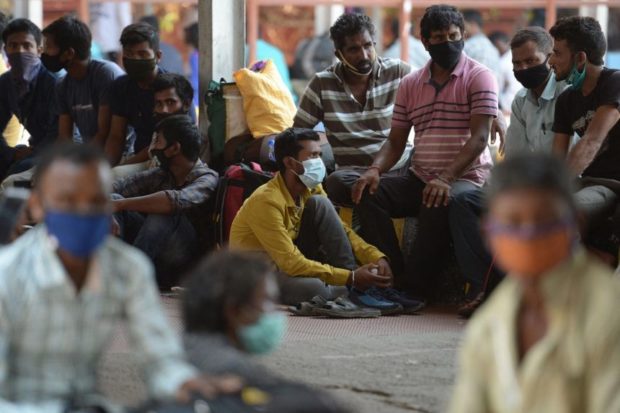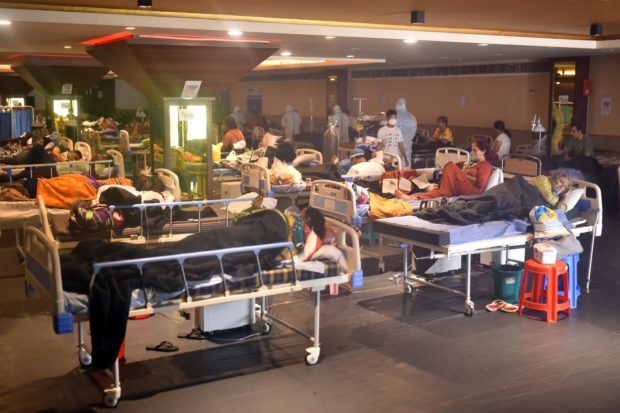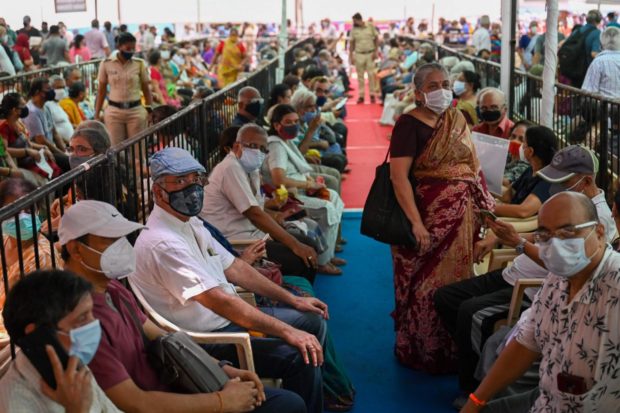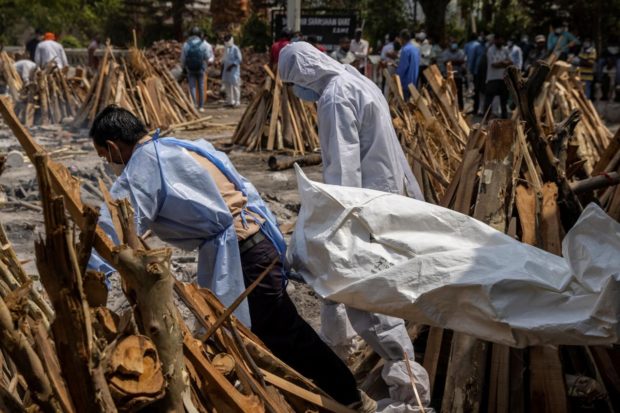Lessons from India’s COVID-19 tsunami

Lulled into a false sense of security by what seems to have looked like falling disease counts, the Indian government and the people let their guard down. AFP via The Straits Times/Asia News Network
In four decades of covering Asia as a journalist and writer, I had thought I’d seen pretty much every type of calamity that leads to mass deaths.
There was the week of communal violence targeting the Sikh community in November 1984, days after two of its members turned their guns on the person they were guarding – Prime Minister Indira Gandhi. Religious passions, a common human frailty, both instigated her assassination as well as the reaction that left thousands of Sikhs dead in the national capital New Delhi and some northern states.
Just a month later, I was in the central Indian city of Bhopal after poorly maintained tanks at the Union Carbide factory led to the toxic mixing of chemicals used to make pesticides, leading to the release into the atmosphere of lethal methyl isocyanate gas.
To this day, a whispered remark from one tenement dweller – who escaped death on that early winter night as the colorless gas entered through the cracks on his door but lived to tell his tale with severely damaged lungs – stays with me: “We were wondering to ourselves, ‘Why are the neighbors pounding chillies so late in the night?’ ”
The gas leak, the worst industrial accident of all time – it killed at least 3,800 and sickened more than half a million – was the fruit of another common weakness, carelessness. In this case, it also came mixed with politics. The Carbide factory had been outside the town when it was built but illegal settlements had advanced to right across the factory gates. Successive governments, afraid of losing votes, had regularized the encroachments.
Two decades later came the Southeast Asian tsunami of December 2004, which took more than 220,000 lives, including some all the way on the east coast of Africa. An act of nature that, distressingly, is all the more frequent these days in Asia.
In some ways, the unfolding health disaster in India is a hybrid of all three; a natural disaster compounded by complacency, misgovernance and power play.
Perhaps it is ironic that it should be happening in a week that the world is marking the 35th anniversary of the Chernobyl nuclear accident in Ukraine, which was then a part of the Soviet Union. If there is a lesson in all this, it is that one can never be too careful.
There’s been enough descriptive coverage of the Indian tragedy but here’s one statistic: This year, more journalists have died of Covid-19 in India than the total number of media people who died covering the two-decades-long Vietnam War.
Among the 100 or so Indian journalists who died was a promising mid-career writer with The Economic Times who Singapore hosted a decade ago in the Temasek Foundation- sponsored Asian Journalism Fellowships. This month, four reporters in Mumbai died on the same day.
Leave it to India to judge its rulers, their response to the Covid-19 threat and how much of the deaths were avoidable. What learning can the rest of us in Asia draw from it? Here are a few.
The complacency virus
Give credit to the Southeast Asian leaders who showed up for their summit in Jakarta last week wearing masks. Some were photographed wearing two. Such messaging from the top is critical. There is no shame in being seen as extra careful.
Lulled into a false sense of security by what seems to have looked like falling disease counts, the Indian government and the people let their guard down. They are paying a price; even the rich, who largely escaped last year’s initial wave.
Politics has contributed to the mess. Prime Minister Narendra Modi, who was vaccinated on March 1, not only welcomed large crowds as he campaigned for his Bharatiya Janata Party (BJP) in several states going to the polls, but he also addressed them without wearing a mask. The Hindu pilgrimage to the Ganges for a cleansing ritual began on March 11. Encouraged by Hindu nationalist leaders, millions attended, making the event a super-spreader.
Complacency as a phenomenon isn’t unique to India. In many parts of Southeast Asia, for instance, anecdotal evidence suggests coronavirus fatigue is in view. Night markets are proceeding in the Ramadan month, malls are visibly crowded on weekends.
Some are paying a price, already. The Malaysian government this week ordered dozens of schools in Selangor and Penang closed after new Covid-19 clusters began showing up. According to the Health Ministry, there were 49 identified clusters in the education sector. While the government has tried to put a stop to the out-migration to the villages during the fasting month, it has kept the night bazaars open so people can access food.
Another big Covid-19 wave could be lethal for regional economies.
Variants of interest and variants of concern
When it comes to viruses and mutations, there is no knowing which way the chips will fall.
If the mutated coronavirus is to visit your city, pray that it is the less virulent variant. At least some of India’s current travails appear to have been inflicted by a double mutant apparently first identified last October that is reportedly the fastest spreading in the prosperous state of Maharashtra of which Mumbai is the capital.
While India certainly seems to have had the short end of the stick, the frightening thought is that it could have been worse. The Indian mutant is apparently less virulent than the British variety.
However, most of the known variants – the UK, Brazilian and South African included – have also manifested in India. The country is on the back foot because it relaxed its guard at the worst time – just as the variants were spreading.

Patients receive treatment inside a Covid-19 care centre and isolation ward facility near a hospital in New Delhi on April 27, 2021. EPA-EFE via The Straits Times/Asia News Network
No nation, particularly ones with large populations and high population density, can relax its guard. Take note, metropolitan Manila, Jakarta, Bangkok and Hong Kong.
Thailand is currently experiencing a new wave, centred on Bangkok. On Tuesday, the city reported 901 new cases in a national total of 2,048, of which only 10 were imported cases.
Canada is in the midst of a third wave of infections. Since Mr Joe Biden took charge as United States President, vaccinations have moved apace for the elderly. But now, younger ones are fetching up with the disease. The New York Times reported on Monday that across Michigan, which is experiencing by far America’s most dangerous outbreak, more younger people are being admitted to hospitals with the coronavirus than at any other time in the pandemic.
Stopping visitors from a particularly affected country may indeed help slow the spread but once the virus is out there, it is a threat to the globe.
Building wider resilience
As this column noted in February last year, advanced countries have known for a while that the next big threat to civilization could come not so much from wars as disease, although the former cannot be ruled out. Indeed, scientific advances have made biological war a very real possibility.
Asia is riddled with huge asymmetries of power, which raises the temptation in both state and non-state actors to consider the use of biological weapons as a leveler. Worldwide, more than a dozen countries have had or are suspected of maintaining biological weapons programs, including several of the so-called P-5 and G-8 nations. They also include states that suffer from an acute sense of vulnerability, such as Israel, Iran and North Korea.
Biological weapons are often called the poor man’s atom bomb, and they attract terrorists because they are relatively cheap to make while offering high returns by way of their huge psychological impact. Use the lessons emerging from India – on medicines, medical equipment, oxygen and supply chains – to build future resilience.
Mutti or Modi, take your pick
And this year will see the departure from office of German Chancellor Angela Merkel. Often called mutti, or mother, her 16 years in office have been marked by stability and she is credited with weathering multiple storms. In some ways, her charisma comes from her ordinariness, seriousness of purpose and predictable behavior.
Flair, looks, gifted oratory and a penchant for the dramatic are not negative traits in leaders but they pale before commitment and competence in office. Earlier this month, this column focused on strongman rulers and why, for the most part, they turn out to be dysfunctional for their nations.
One of the questions from the Indian catastrophe that I have been puzzling over is what happens in Cabinet discussions led by Mr Modi. His minister for health is a qualified doctor and what’s more, chairs the World Health Organizations executive board. Two of his Cabinet colleagues are distinguished retirees from the Indian Foreign Service who’ve spent entire careers focusing on the world outside.
Could they possibly have been oblivious to the second and third waves of Covid-19 afflicting many countries, and did they think India could successfully avoid such an experience? Or were they afraid of bringing bad news to a hard-charging leader who’d convinced himself that he had won the fight?
“Predictions were made that India would be the worst affected by the coronavirus in the world,” Mr Modi had said in a World Economic Forum speech in January. “Today, India is among those countries that have succeeded in saving the lives of the maximum number of its citizens.”
On Feb 21, his BJP said in a resolution that it can be said with pride that India had “defeated Covid under the able, sensitive, committed and visionary leadership of Prime Minister Modi”.

People queue up to receive a dose of a Covid-19 vaccine at a vaccination centre in Mumbai on April 27, 2021. AFP via The Straits Times/Asia News Network
Around the same time as the BJP passed its resolution, India’s infection rate had begun to creep upwards. By mid-March it was evident that the country was staring at a tsunami of new cases.
Yet, on March 29, the Indian foreign secretary presided over the release of a White Paper labelled India: The World’s Pharmacy Expands Its Reach In Global Health. At the event, he commended the paper’s authors for suggesting that India is poised to be more than a pharmacy to the world and could offer a wide range of healthcare solutions to other countries.
In hindsight, as India now accounts for more than one in three coronavirus cases reported worldwide, that seems like a poor joke.
At the end of the day, Asians need to ponder on what type of leaders best serve their interests.
This war is going to be a long one
It is a near certainty that worldwide, there will be more Covid-19 deaths this year than were recorded last year.
Remember Deputy Prime Minister Heng Swee Keat’s letter to the Prime Minister, opting out of the succession race?

Relatives carry the body of a person, who died due to Covid-19, for cremation at a crematorium ground in New Delhi on April 28, 2021. REUTERS via The Straits Times/Asia News Network
With new variants emerging, many expect this to be a prolonged crisis, Mr Heng wrote.
“This year, I am 60. As the crisis will be prolonged, I would be close to the mid-60s when the crisis is over.”
What the words suggest is that in his estimate, this crisis could possibly be around another four years, at least.
It’s a realistic assessment. Even last year, top medical companies knew that this virus outbreak was yet to peak. In India, this second wave is expected to do so only around mid-May.
Make no mistake, this war is by no means over, even for countries with decent track records of vaccinating its people, of which there aren’t many.
For more news about the novel coronavirus click here.
What you need to know about Coronavirus.
For more information on COVID-19, call the DOH Hotline: (02) 86517800 local 1149/1150.
The Inquirer Foundation supports our healthcare frontliners and is still accepting cash donations to be deposited at Banco de Oro (BDO) current account #007960018860 or donate through PayMaya using this link.




















